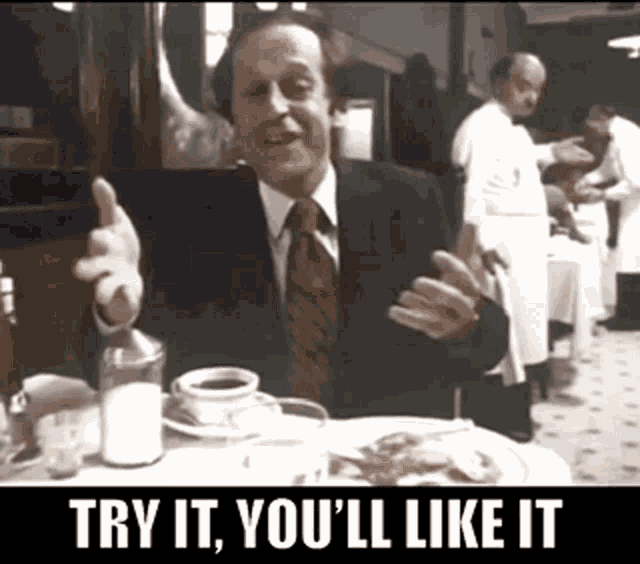- Conquer Sales Newsletter
- Posts
- #18 Beyond the Initial Sale
#18 Beyond the Initial Sale
Mastering Upselling and Cross-Selling for Business Growth
In the bustling bazaars of Istanbul or the chic boutiques of Paris, there's a subtle art that the best salespeople have mastered.
It's not just about making a sale; it's about enhancing the value of that sale.
Enter the world of upselling and cross-selling.
At its core, these strategies aren't just about boosting revenue (though they do that quite effectively); they're about deepening the relationship with the customer, understanding their needs, and offering solutions that genuinely add value to their purchase.
The Psychology Behind Upselling
Ever been to a gourmet coffee shop and opted for the single origin beans instead of the regular one, just because the barista mentioned how those beans have a slight sweetness to the drink?
That's upselling in action.
But why do we, as customers, often say yes?
It's not just about the allure of a fancier drink; it's rooted in our psychology.
Humans are naturally inclined to maximize value. When presented with an option that promises more benefits, especially if the perceived value outweighs the additional cost, we're tempted.
It's the reason why we might opt for a larger TV when the salesperson mentions it's just a tad more expensive but offers a significantly better viewing experience.
Or why, when buying a laptop, we consider the slightly pricier model with double the storage.
It's not impulsiveness; it's our brain's way of seeking the best value.
But there's a fine line here.
Upselling works best when it feels like a genuine recommendation, not a sales pitch.
Think of it as a friend suggesting you try the parmesan fries instead of the regular ones at your favorite diner. They're not benefiting from the sale, but they know the experience is worth the extra bucks.

Identifying Upselling Opportunities
The art of upselling isn't about pushing an upgrade on every customer that walks through the door. It's about discerning which customers would genuinely benefit from a higher-tier product or service.
It's akin to a seasoned chef knowing just when to add a pinch of salt to elevate a dish, not overwhelm it.
Understanding your customer is the cornerstone of effective upselling.
Dive into their purchase history, interactions with your brand, and feedback.
If a customer frequently buys premium skincare products from your online store, suggesting a high-end moisturizer during their next purchase might be apt. On the other hand, upselling a luxury watch to someone who's only ever bought budget-friendly accessories might not resonate.
Let's take the world of SaaS as an example.
A small business that's been using the basic version of your project management software and has seen significant growth might be ready for an enterprise solution with more features. They've outgrown the starter pack, and it's the perfect time to introduce them to the next level. It's not just about making an extra sale; it's about providing a solution that aligns with their evolving needs.
The key is to be observant and proactive.
Monitor customer interactions, feedback, and even complaints.
Often, a complaint about a product's limitation is a hidden upsell opportunity. They're essentially saying, "I wish your product could do this." If you have a version that does, why not introduce them to it?
Techniques for Effective Upselling
Navigating the realm of upselling is akin to mastering a musical instrument. It's not just about knowing the notes; it's about understanding the rhythm, the pauses, and the crescendos.
Here are some harmonious techniques that can make your upselling symphony resonate with your audience:
Product Bundling and Package Deals
Think of this as the classic "meal deal" at your favorite eatery.
By grouping complementary products or services together at a slightly reduced price, customers perceive higher value.
A software company might bundle a year's subscription with a training session, making it easier for businesses to onboard their teams.
Highlighting Premium Versions or Upgrades
Ever noticed how luxury car brands showcase their base model but always have the upgraded version with leather seats, advanced tech, and a sunroof?
It's about presenting the best, making the customer aspire for more.
In Tech, this could mean highlighting the benefits of a Pro version over a Basic one, emphasizing features that cater to growing businesses.
Demonstrating Value and Benefits, Not Just Features
A camera might have a 50MP sensor, but what does that mean for the average user?
Instead, if you mention that it captures memories in stunning detail, making every photo worthy of a frame, you're speaking their language.
It's about translating tech-speak into real-world benefits.
For a CRM software, don't just mention "integrated analytics"; explain how it offers "insights to understand your customers better, leading to more personalised campaigns."
Remember, the essence of upselling lies in authenticity.
It's not about pushing a sale but guiding the customer to a choice that enhances their experience. It's the difference between a pushy salesperson and a trusted advisor who genuinely wants the best for you.

Cross-Selling: Complementing the Main Purchase
Imagine you're at a quaint British bookshop, and as you pick up the latest detective novel, the shopkeeper, with a friendly nod, suggests a guidebook on famous detective stories through the ages.
It's not an upsell; it's a complementary offer that enhances your initial choice.
Cross-selling is about understanding the broader context of a customer's purchase and offering products or services that enhance or complement it.
It's like offering a biscuit with a cuppa or suggesting a protective case when someone buys a new smartphone.
Taking an example from Tech again, consider a company that sells e-commerce platforms. A cross-sell opportunity might be suggesting an email marketing tool or an analytics dashboard. These aren't upgrades; they're tools that can enhance the main product's functionality.
The key to effective cross-selling is relevance.
It's not about pushing any additional product but recommending something that genuinely adds value.
If a customer is buying hiking boots from an online store, suggesting a hiking trail guide or waterproof socks might be apt. On the other hand, offering them a swimsuit might miss the mark.
In essence, cross-selling is about deepening the relationship with the customer.
It shows you understand their needs and are looking out for them, offering solutions that make their experience richer and more fulfilling.
The Do's and Don'ts of Upselling and Cross-Selling
Navigating the waters of upselling and cross-selling can be a bit like preparing the perfect cup of tea.
Too little time steeping, and it's bland; too much, and it's bitter.
Here's a brew of advice to get it just right:
Do Understand Your Customer's Needs
Just as you'd ask a friend if they take sugar with their tea, tailor your upselling and cross-selling suggestions based on a customer's preferences and needs.
If they've always opted for eco-friendly products, suggesting a premium organic range might be spot on.
Don't Be Overly Aggressive
No one likes a hard sell.
It's like being offered a biscuit every two minutes when you've already politely declined.
Offer choices, but respect the customer's decision if they decline.

Do Highlight Genuine Value
If you're suggesting a more expensive laptop because it has a longer battery life, explain why that might be beneficial.
Perhaps it's perfect for those long train journeys from London to Edinburgh?
Don't Upsell Just for the Sake of Upselling
If a customer is perfectly content with their basic phone plan because they rarely use data, pushing a premium plan with unlimited data might not only be unnecessary but could also erode trust.
Do Use Data and Feedback
Keep an ear to the ground.
If several customers mention they wish your software had a specific feature, and you have a premium version that offers it, there's a clear upsell opportunity.
Don't Forget After-Sales Service
Upselling and cross-selling don't end with the purchase.
Offering tutorials, support, or even just a follow-up to see how they're finding the new product can go a long way in building lasting relationships.
In the end, it's all about balance.
Just as you wouldn't pour milk into a cup before removing the tea bag, ensure your upselling and cross-selling efforts enhance the customer experience, rather than overshadowing the main purchase.
Measuring the Success of Your Upselling and Cross-Selling Efforts
You can’t optimise what you don’t measure!
Much like a gardener keenly observing which plants thrive and which wither, businesses must keep a close eye on the effectiveness of their upselling and cross-selling strategies.
After all, what's the use of sowing seeds if you're not going to watch them grow?
Conversion Rate
This is the bread and butter of measuring success.
How many of your upsell or cross-sell offers are actually accepted by customers? If you've introduced a new premium subscription tier on your software platform, how many existing users have made the leap?
Average Transaction Value
By comparing the average spend of customers before and after introducing upselling and cross-selling strategies, you can gauge their immediate impact.
If customers are consistently spending more, it's a good sign your strategies are resonating.
Customer Feedback
Never underestimate the power of a good chinwag. Regularly solicit feedback from your customers.
Are they finding value in the additional products or services? Or do they feel they're being pushed into purchases they don't truly need?
Retention Rate
If customers are not only buying more but also sticking around longer, it's a testament to the effectiveness of your strategies.
It's one thing to upsell a customer once, but if they continue to see value and remain loyal, you're truly onto something special.
Lifetime Customer Value
This metric takes a broader view, looking at the total revenue a customer generates throughout their relationship with your business. Effective upselling and cross-selling can significantly boost this figure, as customers not only spend more but also engage with your brand over extended periods.
Remember, while numbers and metrics provide valuable insights, they're just one piece of the puzzle. Regularly revisiting and refining your strategies, coupled with genuine customer engagement, will ensure your upselling and cross-selling efforts bear fruit.
Challenges and Pitfalls to Avoid
Every strategy, no matter how well-intentioned, comes with its set of challenges.
Upselling and cross-selling are no different.
It's a bit like trying to perfect the art of making a Souflé; sometimes, despite following the recipe, it doesn't rise as expected.
Here's a look at some common pitfalls and how to sidestep them:
Overloading the Customer
While it's tempting to showcase all the bells and whistles, bombarding a customer with too many options can lead to decision paralysis.
It's like being presented with a tea menu with fifty different blends; sometimes, all one wants is a simple English Breakfast.
Misreading the Customer's Needs
Not every customer looking for a compact car is secretly yearning for a sports convertible.
Pushing irrelevant upsells can not only frustrate the customer but also erode trust.
It's essential to listen, understand, and then suggest.
Neglecting After-Sales Support
Imagine buying an intricate piece of software, only to be left in the lurch when you can't figure out how to use it.
Ensuring customers have the necessary support, especially after opting for a more advanced product, is crucial.
Being Too Pushy
There's a fine line between suggesting and pushing.
While the former can enhance a customer's experience, the latter can drive them away. It's the difference between a friendly nudge and a shove.
Ignoring Feedback
If customers consistently decline an upsell or voice concerns about a particular cross-sell, it's a sign to revisit your strategy.
Ignoring such feedback is akin to stubbornly adding more sugar to a cake recipe, even when everyone says it's too sweet.
In the world of upselling and cross-selling, the key is to strike a balance.
It's about enhancing the customer's journey, not derailing it. By being mindful of these challenges and continuously refining your approach, you can ensure your efforts are both fruitful and well-received.
The Future of Upselling and Cross-Selling in a Digital Age
As we stand on the cusp of a new era, where digital transformation is reshaping traditional business models, the strategies of yesteryears might not hold the same charm.
It's a bit like swapping out your trusty old kettle for a state-of-the-art electric one; the essence remains, but the approach evolves.
Personalisation at Scale
With the advent of AI and machine learning, businesses can now offer personalised upselling and cross-selling recommendations to vast audiences.
Imagine an online bookstore that remembers not just your last purchase, but your reading habits, the time you typically shop, and even the genres you linger on, tailoring suggestions accordingly.
Augmented and Virtual Reality
The future might see customers trying out upsell products in a virtual space.
Picture a furniture store where you can virtually place an upscaled, premium sofa in your living room, checking if it matches your decor, all from the comfort of your home.

Chatbots and Virtual Assistants
These digital helpers are becoming increasingly sophisticated.
Soon, they might not just assist with queries but also suggest upgrades or complementary products based on real-time conversations, much like a savvy salesperson in a high-street shop.
Subscription Models and Dynamic Pricing
As businesses lean more into subscription models, there's a vast potential for upselling customers to premium tiers.
Moreover, dynamic pricing, where prices adjust in real-time based on demand, stock, or user behaviour, can offer timely upsell opportunities.
Ethical Considerations
As technology empowers businesses to know more about their customers, there's a growing responsibility to use this information ethically.
Upselling a product based on intimate knowledge of a customer's personal life might be seen as invasive, not savvy.
The horizon of upselling and cross-selling is expanding, driven by technological advancements and changing consumer behaviours. While the tools and platforms might evolve, the core principle remains unchanged: offering genuine value to enhance the customer's journey.
As we embrace the future, it's this ethos that will guide successful strategies, ensuring they remain timeless.
Case Studies: Upselling and Cross-Selling Success Stories
There's nothing quite like a good story to drive a point home.
Success stories serve as both inspiration and a blueprint for others to follow.
Let's delve into a couple of real-world examples that highlight the power of effective upselling and cross-selling.
Spotify: From Free to Premium
Spotify, the music streaming giant, offers a free version of its platform, peppered with ads. However, its upselling strategy is a masterclass in subtlety.
By introducing features exclusive to the Premium version, such as offline listening and ad-free experience, they entice free users to make the leap. The transition is smooth, with the platform often offering trials of the Premium experience, giving users a taste of the benefits.
Moreover, Spotify's Discover Weekly and Release Radar playlists, personalised for each user, serve as a form of cross-selling. While not a direct product, these features enhance the user's experience, making the idea of switching to a competing platform less appealing.
Amazon: "Customers Who Bought This Also Bought..."
Amazon's cross-selling strategy is both simple and effective.
By showcasing products that other customers purchased alongside the item you're viewing, they tap into the principle of social proof. It's a bit like seeing a queue outside a restaurant; you'd naturally assume they serve great food.
Furthermore, Amazon's Prime membership can be seen as an upselling tactic. By offering faster delivery, exclusive access to movies, and special discounts, they provide added value, enticing regular customers to upgrade to the Prime membership.
Both these examples underscore a crucial point: upselling and cross-selling, when done right, don't feel like a hard sell. Instead, they seamlessly integrate into the customer's journey, enhancing their experience and fostering loyalty.
The Delicate Dance of Upselling and Cross-Selling
Upselling and cross-selling, when approached with finesse, can be likened to a well-choreographed dance. Each step, each twirl, is executed with precision, leading to a harmonious outcome. But much like any dance, it requires practice, understanding, and a keen sense of timing.
It's essential to remember that at the heart of these strategies lies the customer. Their needs, preferences, and experiences should guide every decision. It's not about pushing for the sake of higher sales, but about genuinely enhancing the value they receive.
As businesses evolve and the digital landscape shifts, the tools and tactics might change. However, the core principles of understanding, value addition, and genuine engagement will remain timeless. It's these principles that will ensure your upselling and cross-selling strategies not only resonate with customers but also stand the test of time.
TL;DV:
The Art of Upselling: Upselling is about enhancing the customer's initial choice, offering them a superior version or added features.
Why Upselling and Cross-Selling Matter: These strategies can boost revenue, enhance customer loyalty, and improve inventory management.
Strategies for Effective Upselling and Cross-Selling: Personalisation, timely offers, and bundling are key tactics.
Challenges and Pitfalls: Avoid overloading the customer, misreading their needs, and being too pushy.
The Future in a Digital Age: AI, AR, and chatbots are reshaping the upselling landscape.
Case Studies: Spotify and Amazon exemplify effective upselling and cross-selling.
So, as you embark on this journey, take a moment to reflect.
Are you merely selling, or are you enriching?
Are you pushing products, or are you building relationships?
The answers to these questions will determine the success and longevity of your upselling and cross-selling endeavours.
And as always, keep your ear to the ground, listen to your customers, and be ready to adapt.
After all, the business world is ever-changing. But with the right strategies in place you'll be well-equipped to make the most of every opportunity.
Reply